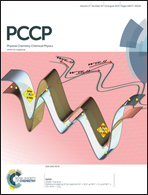Unusual domain movement in a multidomain protein in the presence of macromolecular crowders†
Abstract
Domain movements play a fundamental and critical role in the specific biological function that multidomain proteins have evolved to perform. A significant amount of research has been carried out to investigate the effects of macromolecular crowding agents, mostly on single domain proteins, thereby furthering our appreciation for the crowding phenomenon. However similar studies on proteins having multiple domains are relatively scarce. Using the plasma protein human serum albumin (HSA) as the protein of interest, we have probed the influence of dextran based crowding agents (Dextran 6, Dextran 40, and Dextran 70) on the relative movements of domains I and II using FRET, with Trp-214 in domain II acting as the donor and acrylodan (Ac) covalently attached to Cys-34 of domain I as the acceptor. Amongst the higher molecular weight crowders, while both Dextran 70 and Dextran 40 induced a significant decrease in the distance between the aforesaid domains, however for the latter macromolecular crowder (Dextran 40), beyond 50 g L−1, no change in domain separation was observed even up to concentrations of 175 g L−1. On the other hand, contrary to our expectations, Dextran 6, having the highest packing density by virtue of it being the smallest crowding agent used, provided an asymmetric excluded volume which resulted in forced elongation of HSA along the Trp–Ac FRET axis. Additionally both chemical and thermal studies performed at varying concentrations of the chemical denaturant, urea, reveal unusual movements of the two domains, an aspect that can have important implications with regard to HSA being an avid transporter of fatty acids, with the binding of latter being known to invoke appreciable domain displacements. We hypothesise that we see a distinct crossover from entropy dominated depletion effects in the case of Dextran 6 to significant enthalpic contribution for Dextran 70 with Dextran 40 lying midway between these two crowders, having characteristics of both.


 Please wait while we load your content...
Please wait while we load your content...